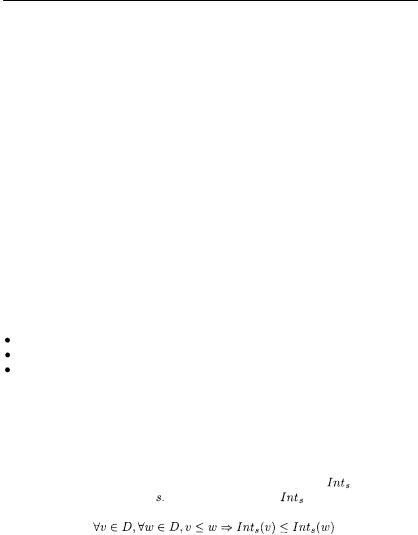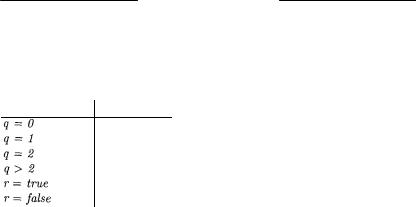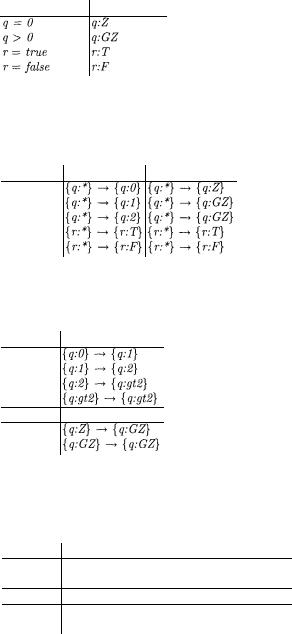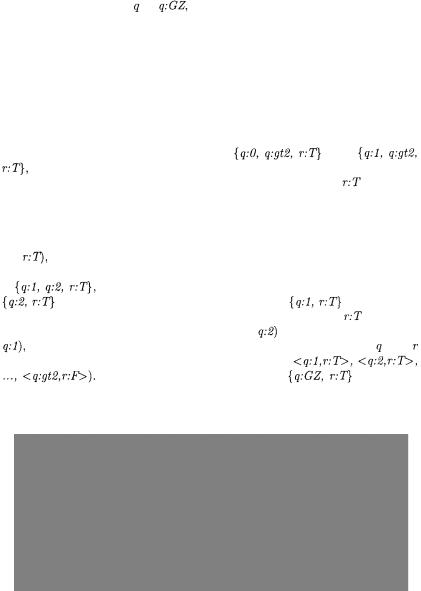
- •Contents
- •Introduction
- •1.1 Reverse Engineering
- •1.2 The eLib Program
- •1.3 Class Diagram
- •1.4 Object Diagram
- •1.5 Interaction Diagrams
- •1.6 State Diagrams
- •1.7 Organization of the Book
- •The Object Flow Graph
- •2.1 Abstract Language
- •2.1.1 Declarations
- •2.1.2 Statements
- •2.2 Object Flow Graph
- •2.3 Containers
- •2.4 Flow Propagation Algorithm
- •2.5 Object sensitivity
- •2.6 The eLib Program
- •2.7 Related Work
- •Class Diagram
- •3.1 Class Diagram Recovery
- •3.2 Declared vs. actual types
- •3.2.2 Visualization
- •3.3 Containers
- •3.4 The eLib Program
- •3.5 Related Work
- •3.5.1 Object identification in procedural code
- •Object Diagram
- •4.1 The Object Diagram
- •4.2 Object Diagram Recovery
- •4.3 Object Sensitivity
- •4.4 Dynamic Analysis
- •4.4.1 Discussion
- •4.5 The eLib Program
- •4.5.1 OFG Construction
- •4.5.2 Object Diagram Recovery
- •4.5.3 Discussion
- •4.5.4 Dynamic analysis
- •4.6 Related Work
- •Interaction Diagrams
- •5.1 Interaction Diagrams
- •5.2 Interaction Diagram Recovery
- •5.2.1 Incomplete Systems
- •5.2.2 Focusing
- •5.3 Dynamic Analysis
- •5.3.1 Discussion
- •5.4 The eLib Program
- •5.5 Related Work
- •State Diagrams
- •6.1 State Diagrams
- •6.2 Abstract Interpretation
- •6.3 State Diagram Recovery
- •6.4 The eLib Program
- •6.5 Related Work
- •Package Diagram
- •7.1 Package Diagram Recovery
- •7.2 Clustering
- •7.2.1 Feature Vectors
- •7.2.2 Modularity Optimization
- •7.3 Concept Analysis
- •7.4 The eLib Program
- •7.5 Related Work
- •Conclusions
- •8.1 Tool Architecture
- •8.1.1 Language Model
- •8.2 The eLib Program
- •8.2.1 Change Location
- •8.2.2 Impact of the Change
- •8.3 Perspectives
- •8.4 Related Work
- •8.4.1 Code Analysis at CERN
- •Index

6
State Diagrams
State diagrams can be used to describe the behavior exhibited by objects of a given class. They show the possible states an object can be in and the transitions from state to state, as triggered by the messages issued to the object.
The effect of a method invocation on a target object depends on the state the object is in before the call. Thus, a description of an Object Oriented system in terms of message exchange only (see previous chapter, Interaction diagrams) does not reveal the state-dependent nature of the class behavior. This is where state diagrams can give a useful contribution.
Reverse engineering of the state diagrams from the code is a difficult task, that cannot be fully automated. The states of the objects in the system under analysis are defined by the values assumed by their fields. However, it is not possible to describe each  of field values as a distinct state, because of their intractable growth, and equivalence classes of field values must be introduced. The definition of such equivalence classes requires a manual intervention, while recovery of the state transitions can be automated, by means of an abstract interpretation of the program. Thus, given an abstract description of the field values and of the primitive operations on the abstract field values, it is possible to automatically derive a state diagram for the class, where the possible combinations of abstract values define the states, while the effects of method invocations are associated with the state transitions.
of field values as a distinct state, because of their intractable growth, and equivalence classes of field values must be introduced. The definition of such equivalence classes requires a manual intervention, while recovery of the state transitions can be automated, by means of an abstract interpretation of the program. Thus, given an abstract description of the field values and of the primitive operations on the abstract field values, it is possible to automatically derive a state diagram for the class, where the possible combinations of abstract values define the states, while the effects of method invocations are associated with the state transitions.
This chapter is organized as follows: the first section summarizes the main features represented in state diagrams and discusses the possibility of reverse engineering them from an existing program. Section 6.2 provides a summary of the main concepts behind abstract interpretation. A thorough treatment of abstract interpretation would occupy a much longer book portion. The presentation given in this chapter aims at providing the basic background knowledge necessary to understand the technique involved in state diagram recovery, which is described in detail in Section 6.3, from an operational point of view. The application of the presented method to the eLib program is discussed in Section 6.4, while related works are commented in Section 6.5.

116 6 State Diagrams
6.1 State Diagrams
The behavior of the objects that belong to a given class can be described by means of state diagrams [1, 7, 31]. States represent conditions that characterize the lifetime of an object, so that objects remain in a given state for a time interval, until some action occurs that makes the state condition invalid and triggers a state transition. Given the fields of a class, the combinations of all possible values define the most detailed decomposition of the class behavior into states. However, such a decomposition is typically impractical, for the huge number of states, and not very meaningful, for the high number of equivalent states. Thus, field values are aggregated into equivalence classes that partition the set of all field value combinations. Each equivalence class is represented as a state and an object is in such a state as long as its field values are in the related equivalence class.
An object may change its state in response to a message it receives. Thus, state transitions are associated to method calls, and the dynamics of an object is abstracted into the state changes induced by method calls.
Available notations for the state diagrams [1, 7, 69] allow for a richer set of properties that can be incorporated into them. For example, each state can be characterized by entry and exit actions, ongoing activity and the inclusion of submachines (contained sub-state diagrams). Moreover, transitions can be guarded by conditions and temporized events can be added to the events of the kind method call. However, for the purposes of this chapter, the basic elements of the state diagrams described above are sufficient. They consist of:
States, identified as equivalence classes of field values.
Transitions, triggered by method calls.
coffee machine example
Fig. 6.1 shows the state diagram for a hypothetical class that manages the main functions of an automatic coffee machine. The coffee machine accepts quarters of dollars in input (up to two quarters), and requires an amount equal to half of a dollar to prepare a coffee. The user can, at any time, insert a quarter, request the return of the quarters inserted so far or request the preparation of the coffee. Of course, the coffee will be prepared only if two quarters have previously been inserted.
The behavior of the coffee machine class, described informally above, is explicitly represented in Fig. 6.1. Let us assume that the class field  records the number of quarters inserted so far, and that the boolean flag
records the number of quarters inserted so far, and that the boolean flag  represents the possibility to request the preparation of the coffee. According to the di-
represents the possibility to request the preparation of the coffee. According to the di-
agram in Fig. 6.1, the initial |
state of the objects of this class after creation |
||
is |
with |
and |
(F represents the boolean value false, while T |
represents |
true). Graphically, |
is identified as the creation state because it |
|

6.1 State Diagrams |
117 |
Fig. 6.1. Example of state diagram describing an automatic coffee machine.
is directly reached from the small solid filled circle, which represents the entry
state of the diagram. |
|
|
|
|
Requests to prepare a coffee ( makeCoffee) or return money (reset) issued |
||
in |
have no effect (self transitions outgoing from |
while the insertion of |
|
a quarter (insertQuarter) triggers the transition from |
to |
In the latter |
|
state, the number of quarters inserted so far is 1 and coffee cannot yet be
prepared |
|
A request to prepare a coffee issued in |
has no effect (self transition), |
while a request to return the inserted quarter has the effect of triggering a transition back to the initial state, as well as the “visible” effect of actually returning a quarter to the user. Insertion of a further quarter originates a
transition to |
where |
and |
|
|
In |
coffee can be prepared |
Thus, an invocation of makeCoffee |
||
has the “visible” effect of delivering the beverage to the user, and has the
“internal” effect of restoring the initial state |
A request to return money |
||
(reset) can also be issued in |
resulting in 2 quarters being returned to the |
||
user, and the system moving to the initial state |
When the coffee machine is |
||
in |
additional quarters cannot be accepted. Correspondingly, their insertion |
||
(call to insertQuarter) does not change the internal state (self transition) and has the effect of immediately returning the inserted coin.
Usefulness of the state diagrams is pretty clear from the example above. The same method call can have very different effects, according to the state of the target object. For example, a call to insertQuarter results in an increment
of |
in |
and |
but not in |
and changes the value of the flag |
only |
in |
While interaction diagrams are focused on the message exchange that |
||||
occurs among a set of collaborating objects, state diagrams are focused on the internal changes that occur within a single object of a given class. The kind of information they provide is thus complementary, and a complete description of the system’s behavior can be achieved by properly combining these two

118 6 State Diagrams
alternative views. In the next sections, a technique for the semi-antomatic recovery of state diagrams from the source code will be defined within the framework of abstract interpretation.
6.2 Abstract Interpretation
The abstract interpretation framework [16] has been deeply investigated and is thoroughly described in a large body of literature (see for example [38]). Abstract interpretation is presented in this section from an operational perspective, with the purpose of providing a survey of the algorithmic details necessary for its usage in reverse engineering of the state diagrams. Some of the theoretical and formal aspects are deliberately skipped.
The aim of abstract interpretation is determining the outcome of any program execution, with any possible input, by approximating the actual program behavior with an abstract behavior. Actual variable values are replaced by abstract values and the effect of each program statement on the variable values is abstracted into the effect it has on the corresponding abstract values. Abstract values represent equivalence classes of actual values, so that the problem of determining all values that all variables may have at each program point and in any execution becomes tractable.
In order to perform an abstract interpretation of a given program, the following entities must be defined:
A domain of abstract values (abstract domain).
A mapping from concrete to abstract values (abstraction).
The abstract semantics of all primitive operations in the given program (abstract interpretation).
The main constraint on the abstract domain is that it must define a complete semi-lattice (with ordering  i.e., its elements must be partially ordered and for each two elements a unique least upper bound must exist. The main constraint on the abstract interpretations of primitive operations is that they must be order-preserving.
i.e., its elements must be partially ordered and for each two elements a unique least upper bound must exist. The main constraint on the abstract interpretations of primitive operations is that they must be order-preserving.
Let us indicate with D the abstract domain, and with |
the abstract |
||
interpretation of statement |
The requirement on |
is the following: |
|
Usually, concrete variable values are replaced by symbolic values which encode entire equivalence classes of values, and the abstract domain is the powerset of the set of symbolic values. The powerset can be partially ordered

6.2 Abstract Interpretation |
119 |
by set inclusion, and such an ordering defines a complete lattice, thus satisfying the constraint on the abstract domain.
Abstract operations are typically defined for individual symbolic, values, the extension to sets of values (i.e., elements of the abstract domain) being straightforward.
The choice of the appropriate abstract domain is crucial, to obtain results that address the original motivation for performing an abstract interpretation of the program. While a too fine-grained domain makes abstract interpretation computationally intractable, a too high-level domain might produce over-conservative results, that are not useful to answer the initial questions on the program. In fact, the output of abstract interpretation is safe, i.e. the values produced in any actual execution are always a “concretization” of the abstract values. However, the latter might be over-conservative, i.e., the abstract values produced by the abstract interpretation might entail concrete values that can never occur in a real execution.
Once abstract domain and abstract operations are defined, the abstract interpretation of the program consists of computing the fixpoint of the abstract values collected at each statement from the predecessors and transformed by the abstract interpretation function associated with such a statement.
coffee machine example
The two state variables in the automatic coffee machine example are  holding the number of quarters inserted so far, and
holding the number of quarters inserted so far, and  which is true when coffee can be obtained from the machine. Different abstract domains can be chosen when performing an abstract interpretation of this program. For example, the following symbolic values can be used for variables
which is true when coffee can be obtained from the machine. Different abstract domains can be chosen when performing an abstract interpretation of this program. For example, the following symbolic values can be used for variables  and
and 
Concrete values Abs value (1)
Another possible abstraction might collapse all values of  greater than zero into a single symbolic value:
greater than zero into a single symbolic value:

120 6 State Diagrams
Concrete values Abs value (2)
Abstract semantics must then be defined for the operations in the program. Since only constant values are assigned to the variables  and
and  the following simplified abstract interpretation table can be defined for the assignment operator:
the following simplified abstract interpretation table can be defined for the assignment operator:
Operation Abs scm (1) Abs sem (2)
q = 0
q= 1
q= 2
r= true
r= false
where  and
and  indicate any symbolic value prefixed respectively by
indicate any symbolic value prefixed respectively by  ’ or
’ or  The abstract semantics of the increment operator is straightfor-
The abstract semantics of the increment operator is straightfor-
ward:
Operation Abs sem (1)
q++
Operation Abs sem (2)
q++
The other operators used in the coffee machine program are relational operators, such as the equality comparison. Since variables are compared only to constant values in this program, the following simplified abstract semantics of the equality comparison can be used:
Operation Abs sem (1)
q == 2 true for the abstract value  false for the abstract values
false for the abstract values 
Operation Abs sem (2)
q == 2 unknown for the abstract value  false for the abstract value
false for the abstract value 

|
6.2 Abstract Interpretation |
121 |
If the abstract value of is |
the result of the evaluation of q == 2 is |
|
unknown, and conservatively one has to assume that both possibilities might occur. When the relational expression q == 2 is part of a conditional statement (e.g., if (q == 2) r = true;), the result of its abstract interpretation determines the way abstract values are propagated forward. If the result is true, the abstract value is propagated only along the then branch of the conditional statement. If the result is false, only the else branch is followed. If the result is unknown, both branches are taken.
The abstract semantics above have been given for individual abstract values, but the generalization to sets of abstract values is easy to achieve. For
example, the increment applied to the set |
gives |
|
i.e., the increment is applied separately to individual values and the re- |
||
sult is the union of the results. Of course, when it is applied to |
it behaves |
|
like the identity. Another example is the equality comparison. Abstract evaluation of q == 2 for  gives false for the first two values and is undefined on the third abstract value. If the condition q == 2 is part of an if statement, all values will be propagated only along the false branch (includ-
gives false for the first two values and is undefined on the third abstract value. If the condition q == 2 is part of an if statement, all values will be propagated only along the false branch (includ-
ing |
since no abstract value reaching the if statement can ever make the |
||||
related condition true. If the set of abstract values |
reaching the |
if statement |
|||
is |
the condition can be both true and false. Correspondingly, |
||||
|
is propagated along the then branch, while |
is propagated |
|||
along the else branch. In order to decide if the abstract value |
should be |
||||
propagated only along the then branch (with |
or the |
else branch |
(with |
||
|
a more refined abstract domain would be necessary, |
in which |
and |
||
are represented jointly (e.g., using the abstract values |
|
|
|
||
|
In the second abstract domain, if |
|
|
reaches the |
|
same if statement, both values must be propagated along both branches of the conditional statement, in that the value of the related condition is unknown.
Fig. 6.2. Example of abstract interpretation under different initial conditions and for different abstract domains.
